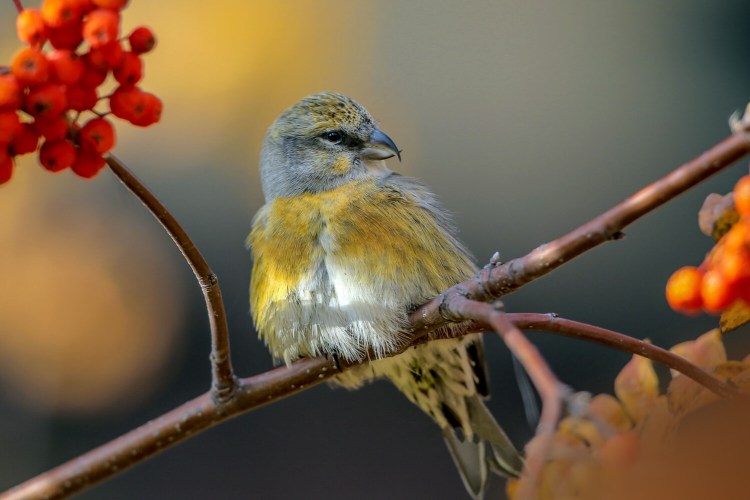In the last column, I wrote about the unusual bills of crossbills. These remarkable structures are perfectly adapted to pry apart the scales of conifer cones, allowing a crossbill to extract the seeds at the base of the scales.
We’ll explore some more aspects of the biology of these birds today.
A look in your field guide will find that we have two crossbills in Maine: the red crossbill and the white-winged crossbill. The Red has a more massive bill and can extract seeds from cones as large as pine cones. The daintier bill of a white-winged crossbill restricts these birds to smaller cones of spruce and larch.
Heavy cone production is not synchronous among conifer species so getting large numbers of both crossbills in the state is an unusual event.
Sadly, a much more common event is for neither species to occur commonly during the winter.
Ron Pittaway, a birder in Ontario, assesses the cone crop of various conifers each fall to predict whether crossbills and other northern finches will move south from their boreal haunts to our part of the country in search of food. Ron reports that spruce crops vary from excellent to bumper in the boreal forests of Ontario, Quebec and Newfoundland. As a result, he does not expect that crossbills will irrupt very far south this winter. Bummer for us!
Crossbills wintering at high latitudes serve as a reminder of the importance of food for wintering birds. As long as birds can get sufficient food, they can pay the high energetic cost to maintain their body temperature in cruel winter weather.
The white-winged crossbill is known to nest in every month of the year. One of my most cherished birding memories is the sight of white-winged crossbills feeding nestlings in January in the Northeast Kingdom of Vermont with a temperature of minus-35 degrees! Obviously, cones were abundant.
Red crossbills provide a real challenge to our understanding of what a bird species is. Beginning with the work of Jeff Groth published in 1993, we know that there are at least 10 types of red crossbills. The types are defined by distinctive flight calls. Differences exist in size and bill shape, patterns of geographic occurrence and preferred food among call types but some overlap in these features muddies the water. At this point, we do not have good information on the genetics of flight calls and on interbreeding between types. Some ornithologists argue that each of these call types could be considered a separate species.
A challenge is that recognizing the calls is difficult by ear. The definitive way is to record the flight call and then analyze it with sound analysis software. Clearly, a challenge to field identification.
But, adequate recordings of the flight calls can be captured with your smartphone. Matt Young, a researcher at the Cornell Lab of Ornithology, monitors recordings of red crossbills uploaded to eBird and can provide a type identification. He has a great site describing the different call types (bit.ly/2DA78NH).
A couple of years ago, one of these call types was elevated to species status. These birds, with the common name of Cassia crossbill, are sedentary birds. Their range is solely within two mountain ranges in Cassia County, Idaho. With their large, thick bills, these crossbills feed on the cones of lodgepole pines. Other crossbill types do not have large enough bills to separate the scales of these large cones.
For unknown reasons, red squirrels are lacking in the two mountain ranges. Squirrels compete with crossbills and other finches for seeds.
Without squirrels, the Cassia crossbills have an abundance of food and need not wander widely like other crossbills to find patchy food.
Climate change is a challenge to the Cassia crossbills. First, warm summer days cause the cones to open prematurely, greatly reducing the seed availability. Second, increasing temperatures reduces the germination of lodgepole pine seeds.
One model predicts that lodgepole pines will be extirpated form Cassia County by 2080.
Herb Wilson taught ornithology and other biology courses at Colby College. He welcomes reader comments and questions at whwilson@colby.edu.
Comments are not available on this story.
Send questions/comments to the editors.


